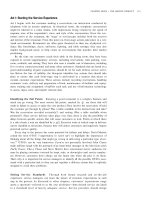Consumer behavior and marketing strategy 12e hawkins motherbaugh chapter 05
Bạn đang xem bản rút gọn của tài liệu. Xem và tải ngay bản đầy đủ của tài liệu tại đây (1.7 MB, 30 trang )
CHAPTER
05
The Changing American
Society: Subcultures
McGraw-Hill/Irwin
Copyright © 2013 by The McGraw-Hill Companies, Inc. All rights reserved.
PART II: EXTERNAL INFLUENCES
5-2
Learning Objectives
Understand subcultures and their influence on unique market behaviors
L01
L01
Analyze the African American subculture and the unique marketing aspects it entails
L02
L02
Analyze the Hispanic subculture and the unique marketing aspects it entails
L03
L03
Analyze the Asian American subculture and the unique marketing aspects its entails
L04
L04
Analyze the Native American, Asian-Indian American, and Arab American subcultures and the unique marketing
aspects they entail
L05
L05
Describe the various religious subcultures and their implications for marketing
L06
L06
Explain the role of geographic regions as subcultures
L07
L07
5-3
Consumer Behavior In The News…
Are All Media Created Equal for Hispanics?
Do you think language preference depends on media type in the Hispanic market?
No
Yes
Source: “Media,” Advertising Age, July 25, 2011.
5-4
Consumer Behavior In The News…
Are All Media Created Equal for Hispanics?
Do you think language preference depends on media type in the Hispanic market?
No
Yes – if you said yes you were correct!
Examples:
TV: English Only = 18%
Internet: English Only = 57%
Why? Hint: Think media demographics.
Source: “Media,” Advertising Age, July 25, 2011.
5-5
The Nature of Subcultures
A subculture is a segment of a larger culture whose members share distinguishing values and patterns of
behavior.
Identification with a Subculture Produces Unique Market Behaviors
5-6
Ethnic Subcultures
African Americans
Hispanics
Asian Americans
Native Americans
Asian-Indian Americans
Arab Americans
5-7
Ethnic Subcultures
Ethnic subcultures are those subcultures whose members’ unique shared behaviors are based on a common racial,
language, or nationality background.
Major Ethnic Subcultures in the US 2010-2030
5-8
Ethnic Subcultures
5-9
Video Application
The following Video Clip demonstrates how Mountain Dew reflects the
increased American value of ethnic diversity in its commercials.
5-10
5-11
5-11
African Americans
Demographics
Buying Power
This group represents $910 billion in buying power and is expected to grow by 25% through 2014.
On average, African Americans are younger than the white population and tend to have less education
and lower household income levels, but differences continue to decrease as a function of education.
Target opportunities exist across a broad range of income. One third of black household incomes
>$50,000.
5-12
African Americans
Segments Identified by Yankelovich
iPod Commercial featuring Mary J. Blige
Which segment does this target?
YouTube Spotlight
5-13
Hispanic Americans
Demographics
Buying Power
Although the average Hispanic household income is relatively low, the purchase power of the Hispanic
market is estimated at $978 billion and is expected to grow by 33% by 2014.
Income, education, language, and identification with Hispanic culture change across generations.
Given that roughly 40% of growth in the Hispanic population is attributable to immigration, the level of
acculturation plays a major role in the attitudes and behaviors of Hispanic consumers.
5-14
Hispanic Americans
A Closer Look at the Marketing Aspects of this Segment
5-15
Hispanic Americans
A Closer Look at the Marketing Aspects of this Segment
Consumer Groups
Generational groups also exist which drive differences in language, national identity, and values.
First Generation
Second Generation
Third (+) Generation
Hispanic teens are often bicultural—acculturating by adding a second culture; not replacing their first
culture.
5-16
Applications in Consumer Behavior
Maybelline's Garnier uses
Spanish-language ads to target
the Hispanic market.
Courtesy Maybelline New York *Garnier.
5-17
Asian Americans
Demographics
Buying Power
Asian Americans are the highest educated and the highest income group.
The estimated purchase power is $509 billion and is expected to grow by 37% by 2014.
This group is also the most diverse group, with numerous nationalities, languages, and religions.
5-18
Asian Americans
A Closer Look at the Marketing Aspects of this Segment
5-19
Native Americans
Demographics
Buying Power
There are approximately 550 Native American tribes, each with its own language and
traditions. Many of the tribes have reservations and quasi-independent political status.
In general, Native Americans have limited incomes, but this varies widely by tribe. The overall
buying power of this group is estimated at $65 billion and is expected to grow by 28% by 2014.
5-20
Native Americans
A Closer Look at the Marketing Aspects of this Segment
Consumer Groups
In recent years, native Americans have taken increased pride in their heritage and are less tolerant of
inaccurate stereotypes of either their history or their current status.
Marketers using Native American names or portrayals must ensure accurate and appropriate use.
5-21
Asian-Indian Americans
Demographics
Buying Power
As a group, they are well educated, affluent, and fluent in English; yet most retain cultural ties to their
Indian background.
In some ways India is more like Europe than America, relative to territories and languages, explaining
the diversity among the members of this group.
5-22
Asian-Indian Americans
A Closer Look at the Marketing Aspects of this Segment
Consumer Groups
While diverse in many ways, most Asian-Indian Americans share many cultural traits, including:
placing a high value on education, particularly their children’s education, and
husbands playing a dominant role in making many of the family decisions.
5-23
Arab Americans
Demographics
Buying Power
This group is somewhat younger then the general population, better educated, and have a higher than
average income.
Since WWII, many Arab immigrants have been business proprietors, landowners, or influential families
fleeing from political turmoil in their home countries.
1
Population estimate by the Arab American Institute.
5-24
Arab Americans
A Closer Look at the Marketing Aspects of this Segment
Consumer Groups
More than 80% of Arab American are U.S. citizens, and a majority being born in the U.S.
Most Arab Americans are tired of negative stereotyping and misrepresentations about their culture.
66% of Arab Americans identify themselves as Christians; 24% identify themselves as Muslims.
5-25









